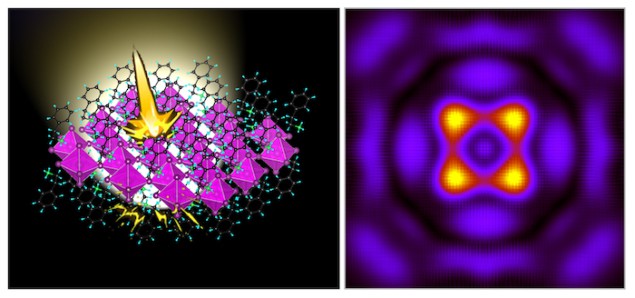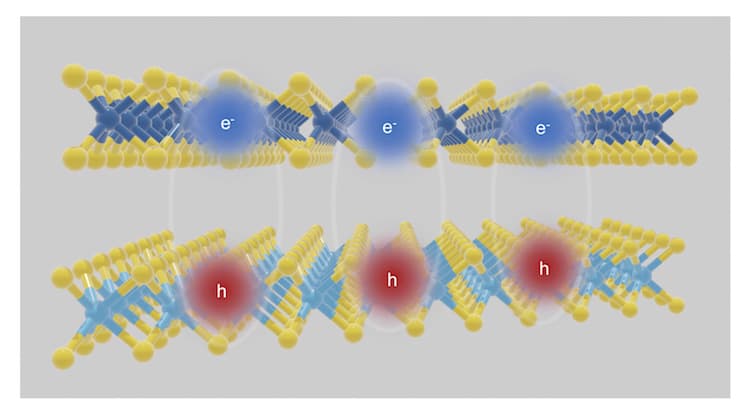Perovskites could be platforms for exciton condensates

Organic–inorganic perovskite materials are usually studied in the context of making solar cells and other photovoltaic devices. Now researchers from the Institute of Semiconductors at the Chinese Academy of Sciences in Beijing have shown that these hybrid halide materials could also be ideal platforms for realizing Bose–Einstein condensates of excitons (electron–hole pairs). Such condensates, which appear as vortex patterns, could be produced at liquid nitrogen temperatures – positively balmy, by the standard of the field – thanks to the long lifetimes of the excitons in the materials and their huge binding energies.
Bose–Einstein condensation (BEC) occurs when all the bosonic atoms or particles in a gas collapse into the same quantum ground state and can therefore be described by the same wavefunction. Such collapses are triggered by cooling the gas until the de Broglie wavelength of its constituent atoms or particles is comparable to the distance between them. Once in this state, the atoms or particles behave as a superfluid, flowing without friction.
Exciton BECs
Researchers made the first BEC in 1995 from rubidium atoms. Since then, condensates have been observed in various other types of particles, including polaritons, photons and magnons as well as other species of atoms and molecules. In all cases, however, the phenomenon has only appeared at ultralow temperatures of no more than a few Kelvin above absolute zero.
To make BECs easier to study – and perhaps also to put their amazing properties to practical use – researchers have long sought to increase the temperature at which they form. One way of doing this might be to make a BEC using excitons, which are bosons composed of the bound states of two fermions: a negatively charged electron and a positively charged hole, or electron vacancy. These fermions are bound together via weak Coulomb interactions that cause them to form dipoles. Since these bound states are much lighter than atoms, they can be packed together with higher density – meaning that they ought to Bose condense at much higher temperatures.
That, at least, is the theory. Unfortunately, previous attempts to make such excitonic BECs – for example in semiconductor wells and graphene – have succeeded only at disappointingly low temperatures of around 1 K, due to the small exciton binding energy in these material systems.
Calculating the exciton binding energy
In their new work, researchers led by Kai Chang studied a 2D hybrid perovskite with the chemical formula (PEA)2PbI4. Perovskites in general are promising thin-film solar-cell materials thanks to the fact that they can absorb light over a broad range of solar spectrum wavelengths. Electrons and holes have a long lifetime in these materials too (that is, they can diffuse through the material over long lengths) and this is the property that Chang and colleagues focused on.
The team’s chosen perovskite has a stable layered structure comprising layers of [PbI6]4− octahedra and long-chain organic molecules with the formula C6H5C2H4NH3+ (abbreviated PEA+). The inorganic PbI4 layers are sandwiched between two organic layers and have effective potential barriers with energies of 8.1 eV. These barriers make (PEA)2PbI4 behave like stacked quantum wells confined by “hard-wall” energy potentials, the researchers explain.
Using first-principles calculations and a theoretical framework known as the Keldysh model, the researchers calculated a binding energy as high as 238.5 meV for the excitons in monolayer (PEA)2PbI4, a value that agrees with that obtained in laboratory experiments. “The Keldysh model is a standard treatment for describing 2D excitons with ‘unscreened’ Coulomb interactions and the large exciton binding energy we calculated means that the critical temperature of the exciton BEC could approach the liquid nitrogen regime (77 K),” team member Dong Zhang tells Physics World.
Vortex patterns
The researchers studied their flakes of (PEA)2PbI4 further by applying an electric field perpendicular to them. From this, they found that the applied field slightly changed the material’s binding energy, while also causing all the electron–hole dipoles to line up in the same direction. In this situation, the interaction between the dipoles becomes repulsive.READ MORE

When the researchers then “pumped” the flakes of the (PEA)2PbI4 using pulses from a laser, they found that the repulsive dipole–dipole interaction created by the perpendicular electric field can drive the laterally confined excitons into various vortex patterns. The time it takes for these vortices to evolve is on a par with the lifetime of the exciton itself and the result is a stable pattern with a certain number of vortices rotating at the centre.
Members of the team, who report their work in Chinese Physics Letters, say they now plan to study exciton BEC in few-layered hybrid perovskites as opposed to just monolayer ones. “We will also be looking at how to manipulate exciton vortices and make vortex-based information-storage porotype devices,” Zhang says.

from physicsworld.com 27/11/2020
Δεν υπάρχουν σχόλια:
Δημοσίευση σχολίου